Birobidzhan: The Jewish Region Without Jews
- Aaron Schorr
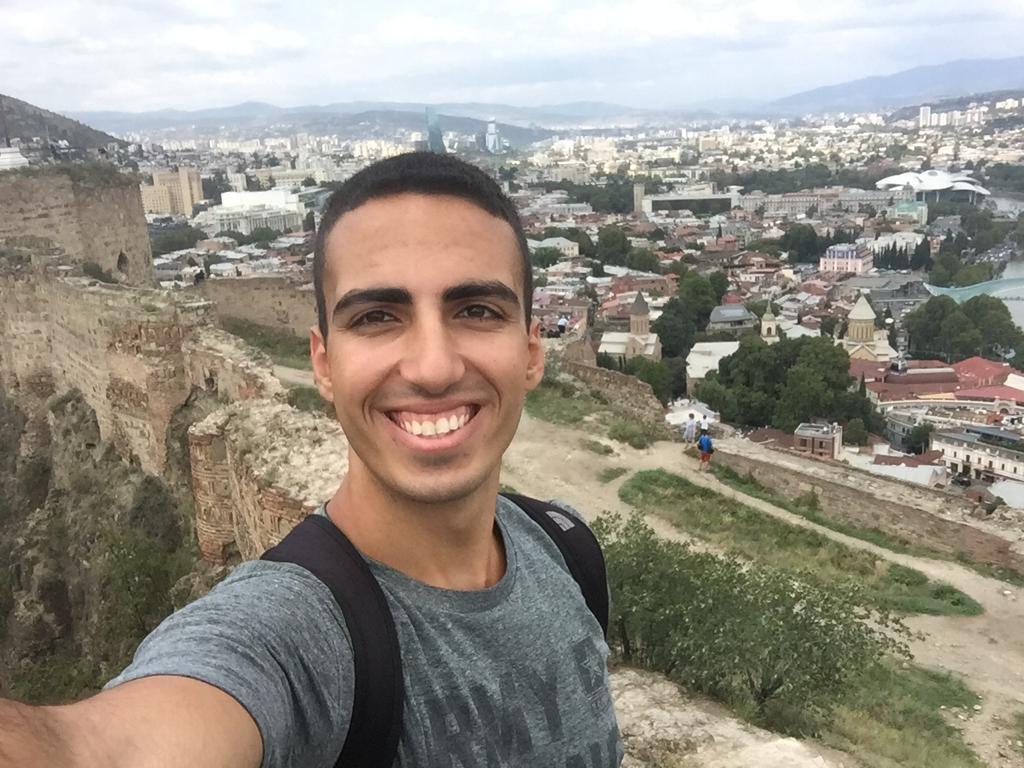
- Mar 29, 2020
- 11 min read
Once again, apologies for taking so long to post this. Last time, I was legitimately busy, but now I've just been taking my time, adjusting to my new reality.
The Trans-Siberian Railroad. The mere name conjures images of romance and adventure the likes of which few other, if any, methods of transportation can hope to replicate. Starting in Moscow's Yaroslavsky station, the railroad snakes its way east across southern Russia, terminating hardly 100 feet away from the Pacific shores of Vladivostok. Making its long journey across 9,289 kilometers and eight timezones, the world's longest railroad has long formed the spine of the vast Russian domain, literally as well as figuratively. Construction of the line was completed in 1916, and it remains a symbol of human triumph over nature.

In the railroad's 104 years of operation, the identity of the country it quite literally holds together has changed twice, the track has been doubled, expanded, and electrified, and connections have been built to the Ukraine, Mongolia, China, and North Korea, but the fundamentals remain unchanged. The full journey takes between six and seven days, the train never moving faster than 80 km/h (and often much slower than that), calling at dozens of stations big and small along the route. I say "the train", but the Trans-Siberian Railroad actually hosts dozen of different trains of various classes and kinds, some traversing the "classic" Moscow-Vladivostok route, others only parts of it, and yet others various domestic and international branches. As a self-proclaimed transit nerd, riding the Trans-Siberian has long been a dream of mine, and I left Vladivostok with a distinct sense of adventure.

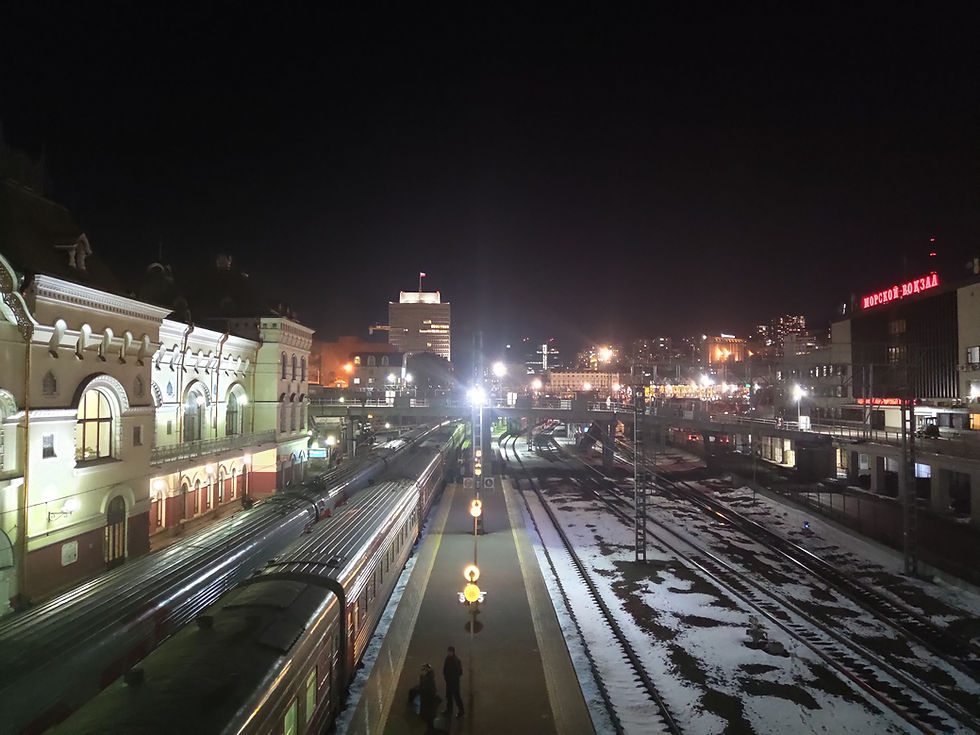
Cruising in Kupe
Many foreign tourists choose to ride the entire length of the railroad in one shot, generally from Moscow to Vladivostok on one of the cushier trains. I believe the journey is incomplete without experiencing the cities of Russia's vast interior, areas nearly cut off from the outside world but for the railroad. Our first trip was to be a relatively short hop to the town of Birobidzhan, heading 850 kilometers primarily north along the Chinese border. Our train was the #007 from Vladivostok to Novosibirsk, roughly two-thirds of the way to Moscow.
Trains in Russia generally run on a three-class system: lyux, cushy private cabins for two people; kupe, small "soft" berths with two bunk beds; and platzkart, "hard" sleeper cars with room for 54 passengers in nine open-plan berths. The differences in price are dramatic, but we chose to travel kupe, getting a decent night's sleep in third-class seeming all but impossible. This is one of the more comfortable trains on the line, with modern carriages to accommodate us on the 16-hour overnight journey. The beds were a tad small but comfortable enough, the ride was mostly smooth and quiet, and there were even USB sockets in the wall.

Every car has a pair of provotniks working in shifts, conductors responsible for looking after the passengers. These take their jobs very seriously and go about them with nearly military pomp, standing by the door in full uniform and fur cap several minutes before each stop, checking the documents of boarding passengers against a handheld device, and providing them with crisp linens to make the beds. The provotnik (or provotnitsa for females, who make up the majority) is also responsible to make sure the urn of hot water in every carriage never runs out, clean the car floors and carpets, and carry a significant stash of snacks, drinks, and souvenirs to sell to passengers. Ours was a polite and somewhat matronly woman, making sure we were aware of our stop half an hour before arriving.
Waking up on the train was somewhat surreal, the Pacific coastline replaced with endless snow-covered brown fields and bare forests. There had been one other passengers in our berth, a man seemingly in his thirties who kept to himself, but he was gone by the time we woke up. Running a train for several days straight requires making long stops for crew replacement, water replenishment, and maintenance, which in Russia for much of the year includes removing the ice accumulated during travel. Our first such stop was in Khabarovsk, 700 kilometers north of Vladivostok on the Amur river. The skies were deceptively blue, but there was no mistaking the cold of the Russian interior that hit us full in the face, the temperature having dropped to -9° overnight.
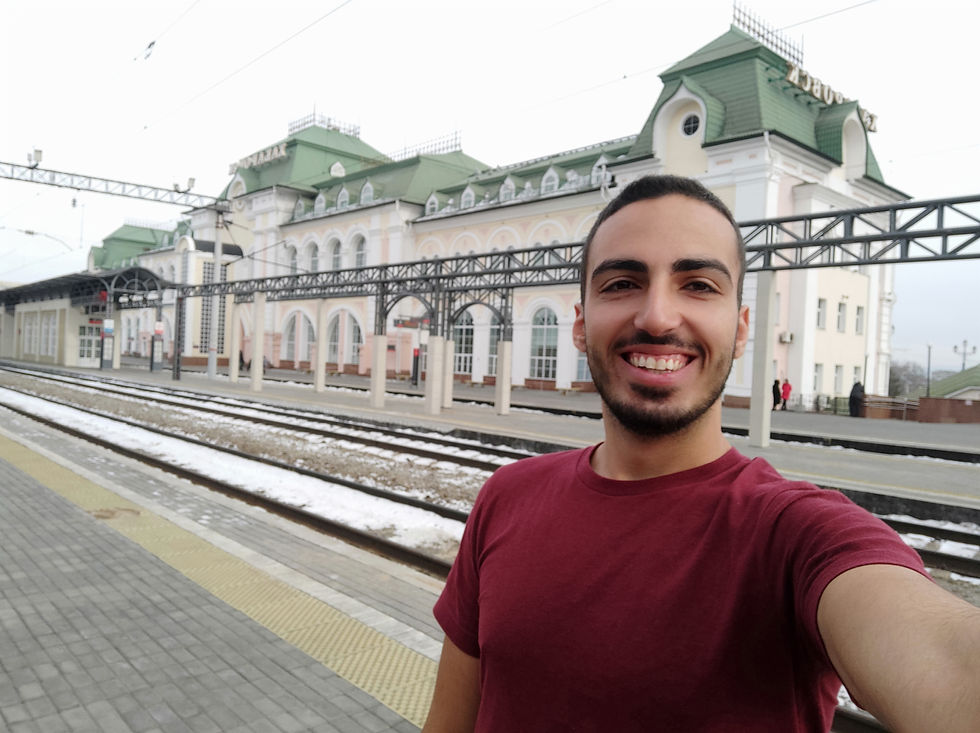
We hadn't expected to get any food, but the provotnitsa walked in at 9 am with packaged breakfast. The food was about as Russian as it gets - rice and sausages, black bread, and salami, in case one form of sausage wasn't enough. We only had a few hours to pass before arriving in Birobidzhan, and we did so drinking green tea and watching the scenery pass by.

Where the Jews Aren't
Birobidzhan is unique to say the least of it, earning a respectable spot on the list of the world's oddest places. Faced with mounting ethnic tensions in the vast and diverse Soviet Union, Stalin had the idea in the early 1930s to create a series of semi-autonomous republics for various ethnic groups in which they could have a semblance of independence within the greater USSR. One of these was to be the Jewish Autonomous Oblast, through which he hoped to both reduce friction between Jews and their neighbors and attract donations by wealthy Jewish communities in the United States. After a previous attempt to establish Jewish collective farms in Crimea had failed, the location for the new Oblast was to be no other than the remote Far East, a virtually empty region in desperate need of settlement.
Thus Birobidzhan was founded, a Jewish town on the Trans-Siberian Railroad just over 6,000 kilometers east of Moscow as the crow flies. A Yiddish theater was opened, Yiddish newspapers were founded, and the project inspired hopes for a Jewish homeland among many, attracting thousands of Jewish settlers and many intellectuals, who saw Birobidzhan as an opportunity to create a center of modern Jewish culture.
The bubble burst pretty quickly. Farming here turned out to be a colossal failure, the cold and swampy land unsuitable for agriculture, and the residents nearly starved to death several winters. Stalin's feelings towards the project changed rather drastically in the years to follow, with all forms of religious practice banned and many community leaders arrested and sent to prison. The community steadily declined in the decades following the war, until the vast majority emigrated to Israel, the US, and Germany after the collapse of the Soviet Union (I am personally friendly with two people born there). The Jewish Autonomous Oblast, however, has endured despite everything to this day, albeit with few Jews left. I had been interested in Birobidzhan since meeting someone from there for the first time roughly three years ago, and my interest was piqued further by reading Masha Gessen's excellent book, Where the Jews Aren't. A Trans-Siberian journey was the perfect opportunity to visit.
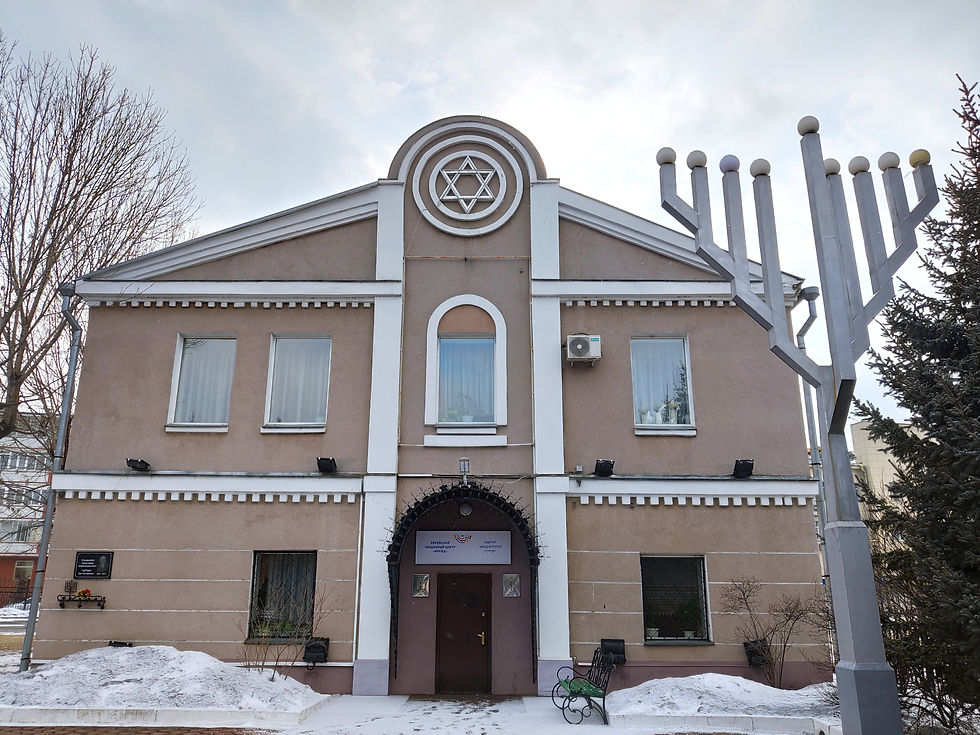
Arriving rather spontaneously in the Russian Far East, I hadn't had the time to plan much in advance or get in touch with the local Jewish community. I had, however, found a Couchsurfing host who offered to meet us at the station and help us discover the town. Vasilina and her husband Sergey were an interesting couple, avid travelers who had lived all over Russia and in Crimea until its annexation by Russia, after which "everything fell apart", as they put it. Climbing into their car (obviously Japanese-made and with the wheel on the right), I instinctively reached for my seatbelt. "Oh, that's not necessary," said Sergey, but I buckled up anyhow. I had almost forgot where I was, perhaps confused by the huge menorah and the "ביראבידזשאן" sign in front of the station.
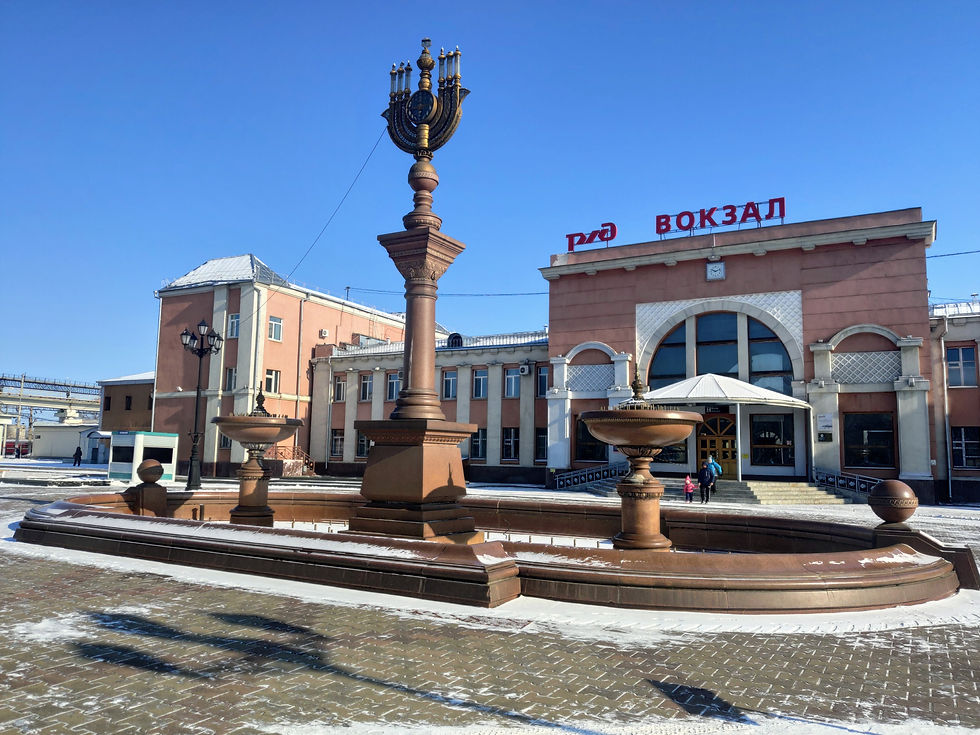
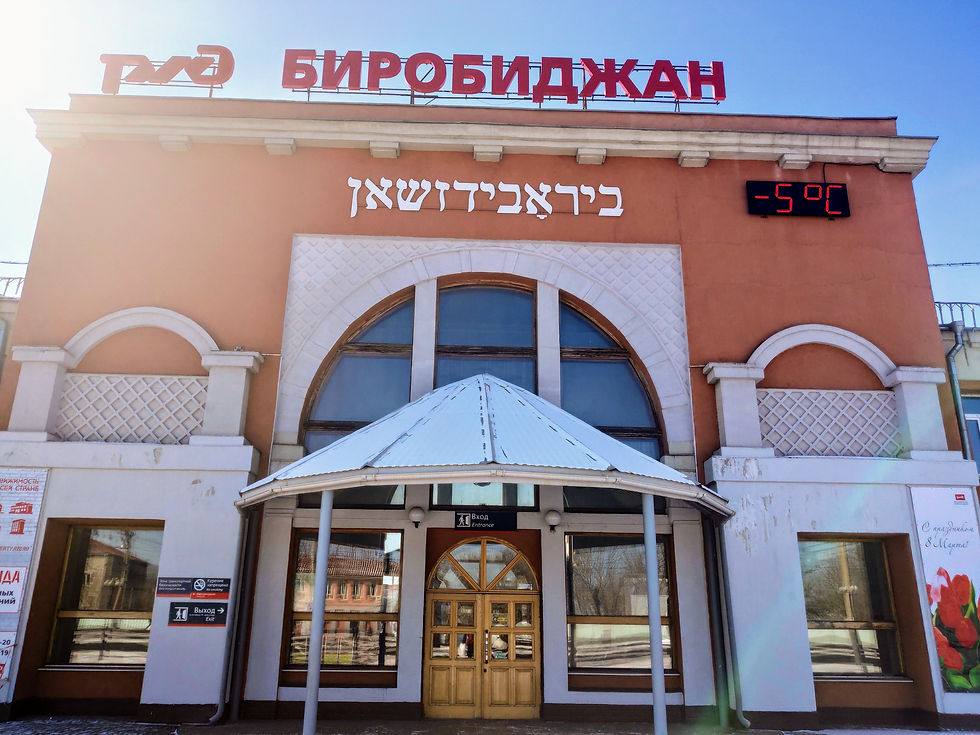
Vasilina was an English teacher and had offered to join one of her adult English lessons. I was all too happy to agree and see a side of Russia few tourists ever do. It being 1 pm on a Thursday, the class was quite small, with only two female students in their thirties - Helen (Elena) and Anne (Anya). Both women would turn out to be housewives from out of town; both spoke extremely limited English. Talking to them was an incredible insight into "real" Russians, middle-class housewives living in a forgotten town closer to Anchorage than to Moscow.

Helen was from Blagoveshchensk, "the next town over", which in Russia meant it was 500 kilometers away, and enjoyed traveling to sunnier parts of Asia. Anne, on the other hand, was a real firecracker, having grown up in the Russian Caucasus before moving to the Far East for her husband's work. She was full of complaints about life in Birobidzhan - the people were cold, the weather was miserable, and there was nothing to do. The result, as she put it, was that she spent her time "wasting her husband's money".
Yiddishkeit in the Far East
The lesson concluded, we set out to discover what was left of the town's Jewish history. The first sign was, well a sign, as most of the street signs downtown are in both Russian and Yiddish.
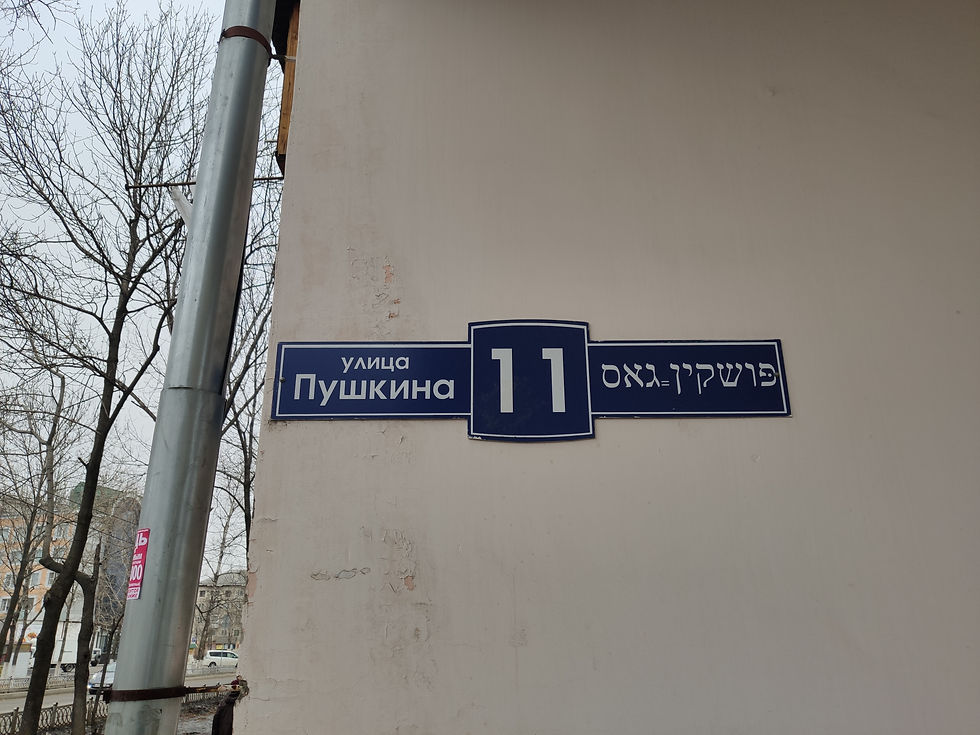
The Jewish community center was down Lenin St, past two sculptures that seemed to define the cultural crossroads that is (or was) Birobidzhan. The first was a ten-foot-tall bronze rendering of Sholom Aleichem, the Yiddish author and playwright who also has one of the main streets named after him, and the second was Victory Square, a fixture of every Soviet town and city, complete with eternal flame and plaques commemorating each of the town's sons who earned a medal during WWII. None of the dozen or so names appeared to be Jewish.
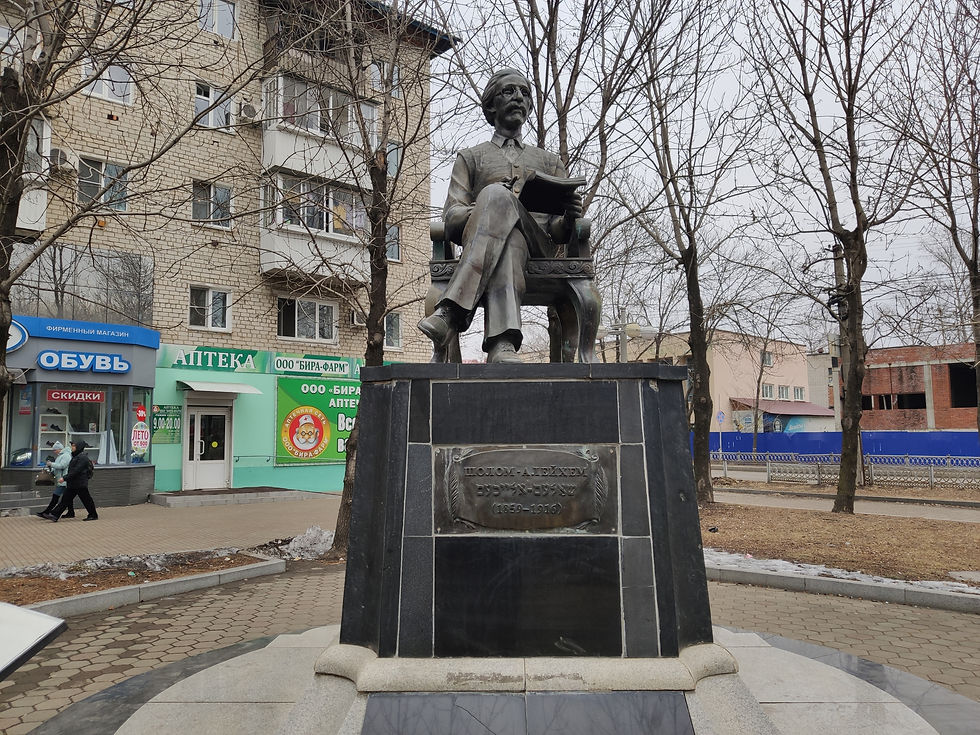
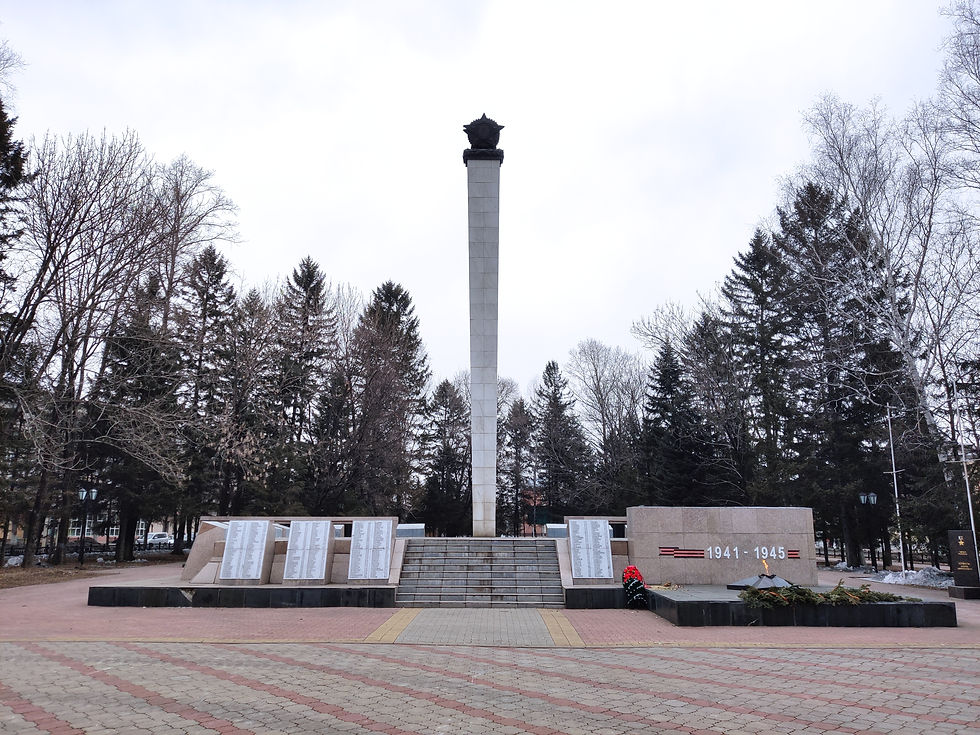
One of the more interesting buildings was the post office, with "פאטשט-טעלעפאן-טעלעגראפ" (post-telephone-telegraph) emblazoned on the facade, another relic of a forgotten world.
The community center had a kosher restaurant named Simcha, written in Cyrillic characters that were supposed to look like Hebrew ones.

Keeping with the menu's theme of mixing classic Ashkenazi Jewish with modern Israeli, I ordered kreplach and hummus, certainly a rare find in this part of the world. The food was alright, not quite managing to provide a taste of home, but the people-watching was fascinating. There were several other groups of customers in the restaurant, not a single one of which seemed to be Jewish. It seemed local residents were happy to go to the kosher restaurant (which was significantly more expensive than other places), since it appeared to be the fanciest restaurant in town.

While we were eating, we had seen the wait staff frequently go in and out of a side door from which lively music was playing. We decided to have a look on our way out, following the music upstairs to a separate event space. An accordion player faced two long tables full of retirees, some wearing kippas, who were singing what sounded like folk songs in Russian. A woman approached us.
"Who are you?" she asked in Russian.
"We're from Israel."
"Ya vizhyu eto!" I can see that!
She and a man seated by the entrance had a chuckle at our expense. The man sported a beard and was dressed nicely, so I figured odds were that he was the local rabbi.
"Do you speak Hebrew?" I asked.
"Nyet." He laughed. "Of course I do!"
He welcomed us in, switching to Hebrew. He was very surprised to see us, wondering why we "weren't in India like everyone else" and admitting they weren't used to getting visitors our age, especially in winter. He explained we had stumbled upon a Purim after-party for the senior members of the community ("Don't worry, there are plenty of young people, too") and invited us to join. We declined and asked him if we could have a look at the synagogue, which he was happy to show off. I had been to dozens of synagogues all over Europe, but none of them had as much Yiddish as Beis Menachem in Birobidzhan.

The rabbi was a strange character, having grown up completely secular on a kibbutz in the north of Israel and spent most of his adult life in Russia, which rather befit his strange community, which he said was 300-400 strong. There were both a Jewish kindergarten and a Jewish school in the town, he told us, both with Yiddish curriculums and a minority of Jewish children. "Imagine that, a Chinese-Russian kid speaking Yiddish!"
What I couldn't figure out is why Birobidzhan still retains its autonomy and Jewish character, decades after the official admission that the project had failed. What interest did the Russian government have in keeping the Jewish Autonomous Oblast alive? The rabbi had his theory: "Why do people hate?" he asked, "Because they don't know." According to him, antisemitism was all but non-existent in Birobidzhan, since the locals were all familiar with Judaism from a young age, and the federal government had an interest in mitigating antisemitism. Classic Chabad answer, but I wasn't satisfied.
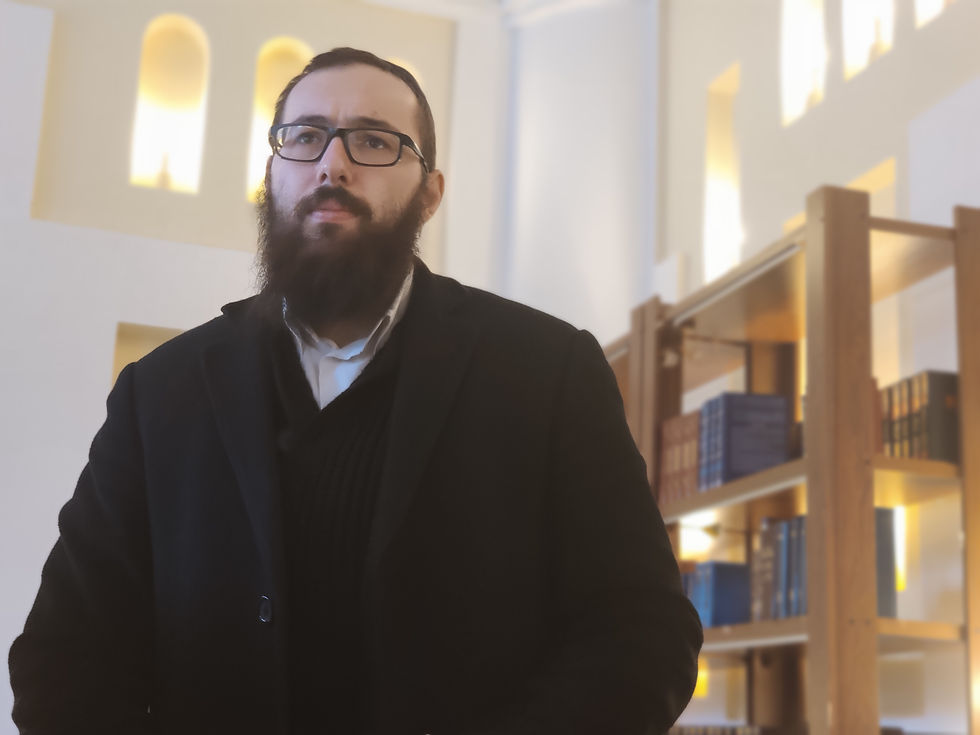
The answer seemed to leap out at me wandering the streets of the town. After strolling down the riverside promenade and walking on the frozen river itself, we ended up in the adminstrative center, built around an enormous square, bare apart from the ubiquitous statue of Lenin.
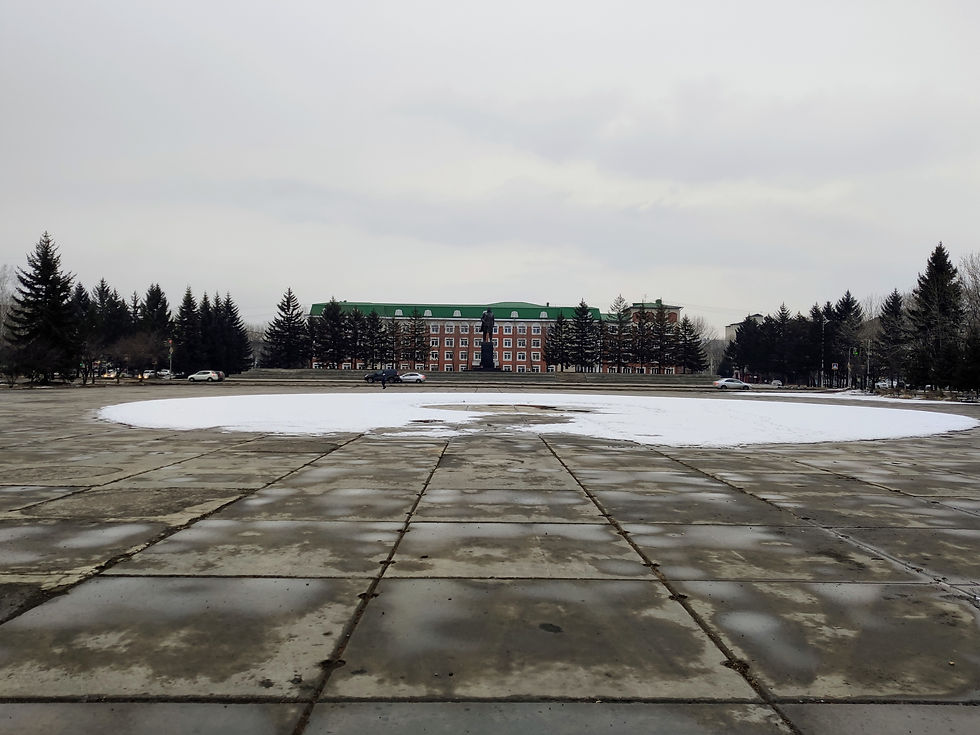
The east side of the square had a large government building, with a sign reading "Government of the Jewish Autonomous Oblast" in both Yiddish and Russian; the west had the district court. There was obviously money to be made by retaining a local government, I realized, with jobs, institutions, and funding that would disappear if the Russian government did the "logical thing" and dissolved the Oblast. Thus the town retained its long-obsure Jewish character due to a strange alignment of interests - the federal government wanting to appear philosemitic, the Jewish community wishing to preserve their corner of tolerance and self-determination, and the non-Jewish local residents enjoying the financial benefits of regional autonomy.

A Trip to the 1960s
We headed back into the town center just as snow started to fall. Daylight all but faded as the sky turned overcast and the snowfall became much more intense, bathing the town in a strange yellow haze. Luckily for us, Vasilina had just finished working, so we hurried back across town to the language school to catch a ride with her. There was steam rising out of the exhaust, so I thought Sergey was waiting inside, but it turned out Russians had a gadget that allowed them to switch on their cars remotely, which was a much cheaper solution than the engine block heaters typical of cold places in the US and Europe.
Vasilina and Sergey lived in a small apartment that didn't have room for guests, but her mother had graciously offered to host us instead. We were heading there with Vasilina's ten-year-old son Yaromir, who had a penchant for skyscrapers. Unfortunately for him, his hometown was somewhat lacking in that department, the tallest building being a nine-story residential block that was much wider than it was tall. When we told him we had seen Taipei 101, until 2007 the world's tallest building, the previous week, his eyes lit up as if we had told him we had been to Mars.
Vasilina's mother Svetlana lived in a two-bedroom apartment in a typically Soviet residential development at the edge of town. In a pattern repeated everywhere behind the Iron Curtain, solemn five-story brick apartment buildings the length of a city block surround a central courtyard which is used for recreation and parking. The buildings are known as khrushchyovkas, named after the Soviet premier who championed their construction across the USSR and Eastern Europe, and are almost never taller than five stories, which was the official Soviet height limit on buildings without elevators. What the developments lack in charm they make up for in utility and cost, or so the logic goes. Just being in Birobidzhan had felt like a journey back in time to the Cold War, and Svetlana's apartment only made it stronger.

We found Svetlana to be an extraordinarily kind woman, treating us as if we were long-lost family. She served us the obligatory tea, followed by perhaps the most Russian of meals: borscht and black bread. After we had eaten, she smiled widely and said she was "relaxed" after knowing that we weren't hungry and insisted that we sleep in her room, since the couch-bed in the other room would be too small for us. All protest was futile; she was having none of it. We were total strangers who could hardly have a coherent conversation with her due to the language barrier, but she did everything she could to make us feel comfortable, even offering to take us to the train station the following morning. I was deeply touched by her hospitality and wished I had the Russian skills to thank her fully.
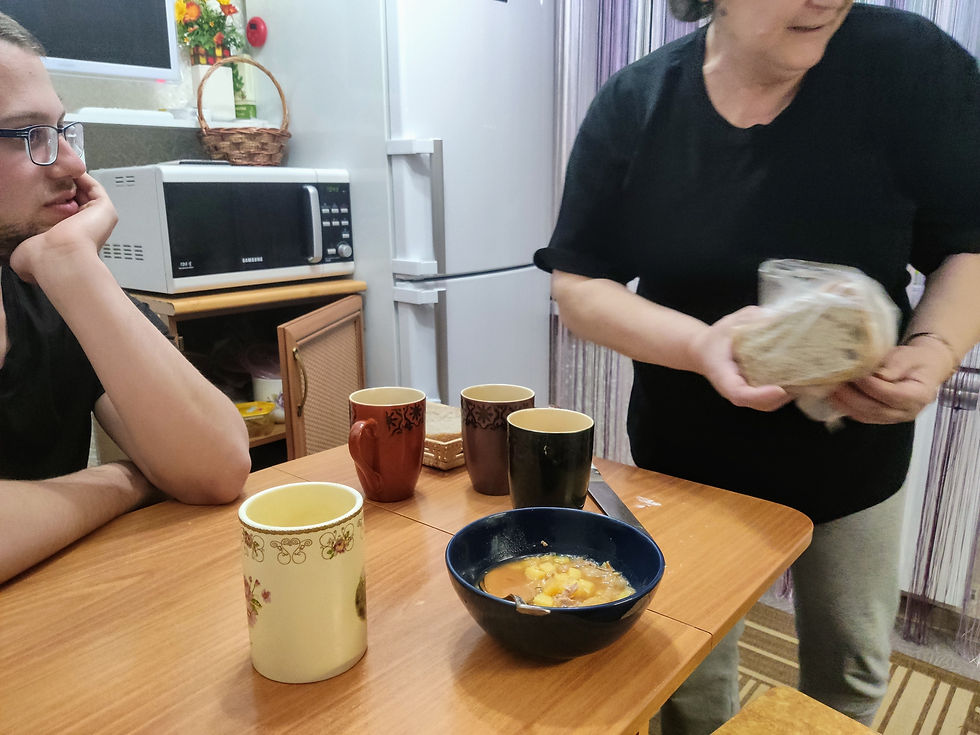





Comments